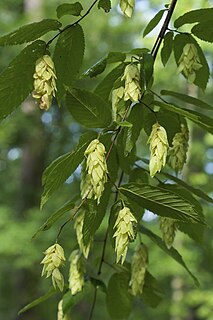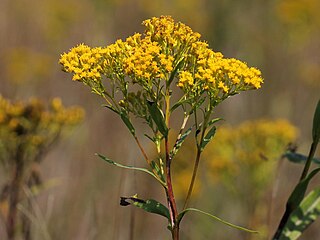Related Research Articles

Solidago, commonly called goldenrods, is a genus of about 100 to 120 species of flowering plants in the aster family, Asteraceae. Most are herbaceous perennial species found in open areas such as meadows, prairies, and savannas. They are mostly native to North America, including Mexico; a few species are native to South America and Eurasia. Some American species have also been introduced into Europe and other parts of the world.

John Torrey was an American botanist, chemist, and physician. Throughout much of his career, Torrey was a teacher of chemistry, often at multiple universities, while at the same time pursuing botanical work. Dr. Torrey's botanical career focused on the flora of North America. His most renowned works include studies of the New York flora, the Mexican Boundary, the Pacific railroad surveys, as well as the uncompleted Flora of North America.

Helianthus is a genus of plants comprising about 70 species. Except for three species in South America, all Helianthus species are native to North America and Central America. The common names "sunflower" and "common sunflower" typically refer to the popular annual species Helianthus annuus, whose round flower heads in combination with the ligules look like the sun. This and other species, notably Jerusalem artichoke, are cultivated in temperate regions and some tropical regions as food crops for humans, cattle, and poultry, and as ornamental plants. The species H. annuus typically grows during the summer and into early fall, with the peak growth season being mid-summer.

Symphyotrichum is a genus of about 90 species of herbaceous annual and perennial plants in the composite family (Asteraceae) that were formerly treated within the genus Aster. The majority are endemic to North America, but several species also occur in the West Indies, Central and South America, as well as in eastern Eurasia. Many species have been introduced to Europe as garden specimens, most notably the New England aster and the New York aster.

Ostrya virginiana, the American hophornbeam, is a species of Ostrya native to eastern North America, from Nova Scotia west to southern Manitoba and eastern Wyoming, southeast to northern Florida and southwest to eastern Texas. Populations from Mexico and Central America are also regarded as the same species, although some authors prefer to separate them as a distinct species, Ostrya guatemalensis. Other names include eastern hophornbeam, hardhack, ironwood, and leverwood.

Astereae is a tribe of plants in the family Asteraceae that includes annuals, biennials, perennials, subshrubs, shrubs, and trees. Plants within the tribe are present nearly worldwide divided into 170 genera and more than 2,800 species, making it the second-largest tribe in the family behind Senecioneae. They are found primarily in temperate regions of the world.

Iva is a genus of wind-pollinated plants in the daisy family, described as a genus by Linnaeus in 1753. Plants of this genus are known generally as marsh elders. The genus is native to North America.

Artemisia ludoviciana is a North American species in the daisy family, known by several common names, including silver wormwood, western mugwort, Louisiana wormwood, white sagebrush, and gray sagewort.

Aphanostephus (dozedaisy) is a genus of flowering plants in the daisy family, Asteraceae.
Bradburia is a North American genus of flowering plants in the daisy family, native to the southern United States.

Helianthus occidentalis is a species of sunflower native to the Eastern and Central United States. It grows mostly in the Great Lakes Region and in the Ozarks, with additional populations scattered as far as Massachusetts, Texas, and the Florida Panhandle.

Quercus turbinella is a North American species of oak known by the common names shrub oak, turbinella oak, shrub live oak, and gray oak. It is native to Arizona, California, New Mexico, Utah, Colorado, and Nevada in the western United States. It also occurs in northern Mexico.
Baccharis salicina is a species of North American plants in the sunflower family. Common names include willow baccharis, and Great Plains false willow.

Symphyotrichum oolentangiense, commonly known as skyblue aster or azure aster, is a species of flowering plant in the family Asteraceae, native to eastern North America.
Ageratina rothrockii is a North American species of plants in the sunflower family. It is found only in the southwestern United States in the states of Arizona, New Mexico, and Texas, as well as the states of Sonora, Coahuila, Chihuahua, and Durango in Mexico.

Aphanostephus skirrhobasis, common name Arkansas lazydaisy, is a North American species of flowering plants in the daisy family. It is native primarily to the southern Great Plains of the United States with additional populations in Florida and the Mexican state of Tamaulipas.
Brickellia lemmonii is a North American species of flowering plants in the daisy family. It is native to northeastern and north-central Mexico and the southwestern United States.

Solidago riddellii, known as Riddell's goldenrod, is a North American plant species in the genus Solidago of the sunflower family. It grows primarily in the Great Lakes and eastern Great Plains of Canada and the United States. It is sometimes considered part of the genus Oligoneuron, but as a Solidago, included in the section Solidago sect. Ptarmicoidei, the flat-topped goldenrods.

Hypericum gymnanthum, the small-flowered St. John's wort or clasping leaf St. John's wort, is a species of flowering plant in the St. Johnswort family native to wet woods, bogs, and ditches of the eastern United States and Guatemala. It has been introduced to Poland.

Solidago sect. Ptarmicoidei is a section of flowering plants in the genus Solidago. They are sometimes considered a separate genus: Oligoneuron. Like related species they are known as goldenrods. This section contains seven species of perennial herbs, all native to North America. They are distinguished from other goldenrods by their corymbiform flowerheads, which are flat or rounded in profile and about as broad as tall or broader, for which they are sometimes called flat-topped goldenrods.
References
- ↑ Biota of North America Program 2014 county distribution map
- ↑ Flora of North America Vol. 20 Page 352 Plains lazydaisy , Aphanostephus riddellii Torr. & A.Gray
- ↑ Turner, B. L. 1984. Taxonomy of the genus Aphanostephus (Asteraceae–Astereae). Phytologia 56: 81–101.
- 1 2 Torrey, John & Asa Gray. 1842. Flora of North America 2(2): 189